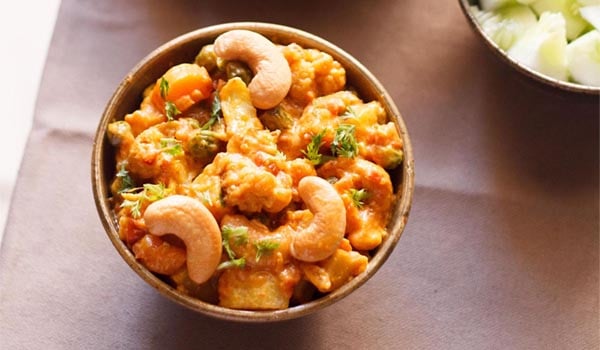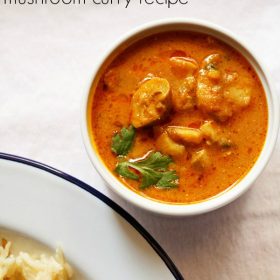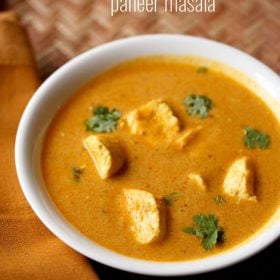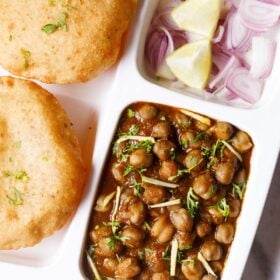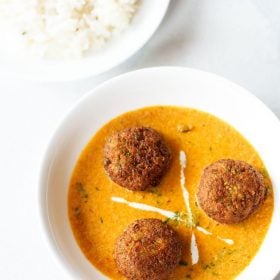Want a simple yet delicious curry recipe with the goodness of lots of vegetables in it? Here’s exactly what I have for you. Check out this Vegetable Curry Recipe of mine that I have shared on this post. This is a Punjabi or North Indian-style Vegetable Curry made with fried mixed vegetables in a luscious creamy spiced onion-tomato gravy. Best paired with all your Indian flatbreads and even cumin rice, for a comforting meal.
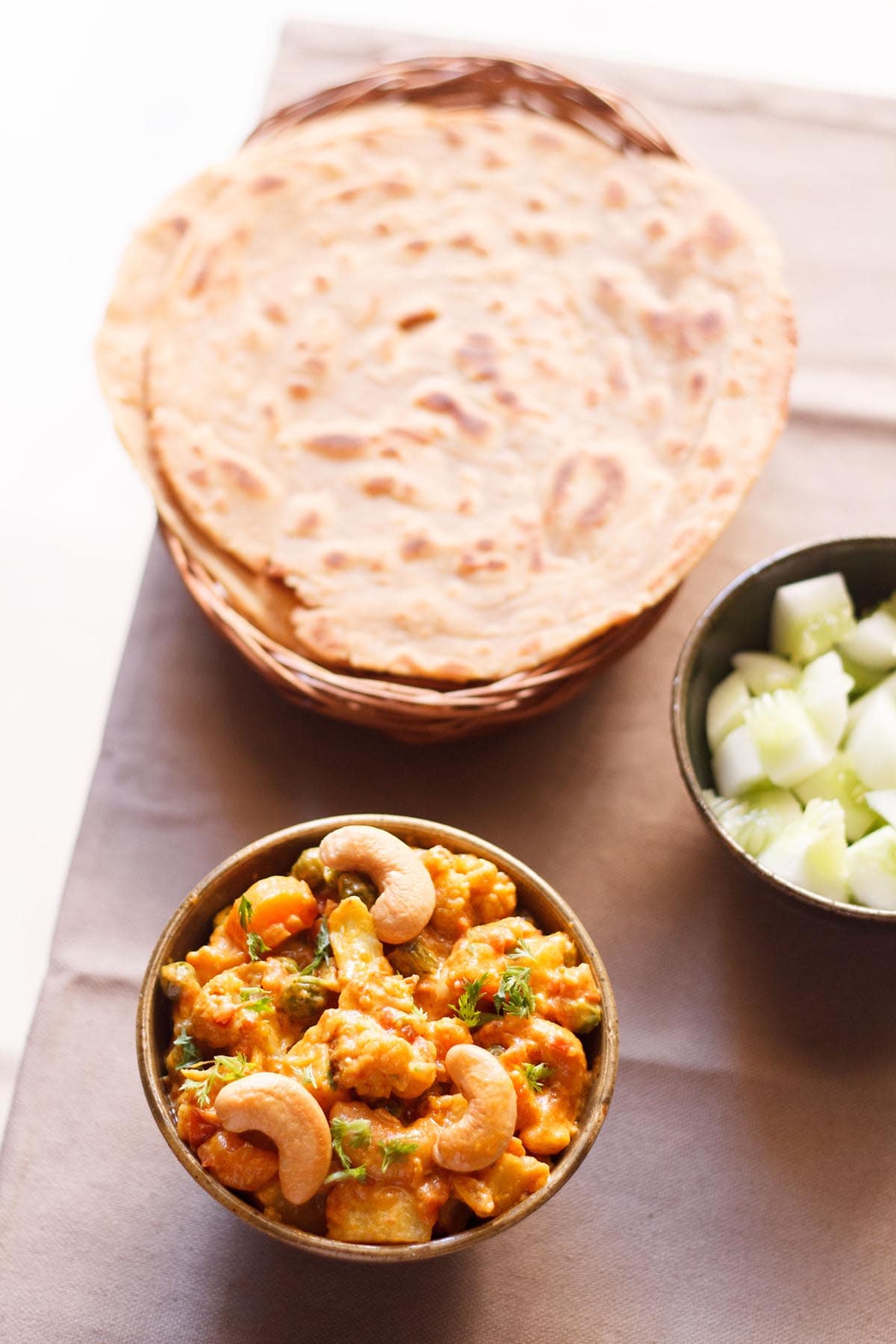

About Vegetable Curry Recipe
A variety of mixed vegetable recipes are common both in North Indian as well as South Indian cuisines. As it is also a favorite in my house, I have a few variations of preparations that include mixed veggies in them.
Some are dryish, others semi-dry or curry based. This recipe of Vegetable Curry is one way that I make, with typical Punjabi flavors in it.
I had seen this Vegetable Curry Recipe on a television show decades back. Post which, I tried it at home. And when I did that, the results came out really good. Since then, it is much-loved by all at my place.
Sometimes, I just make this version, pair it with our regular chapatis and some fresh salad on the side, and a satisfying lunch or dinner is sorted.
The gravy of this Vegetable Curry is creamy, mildly sweet and subtly spiced with a hint of sourness from the tomatoes and curd (yogurt).
The recipe calls for frying the veggies. Alternatively, you can sauté the vegetables or blanch or steam them too. However, since fried veggies and cream is used, the dish becomes rich in calories.
Since this post is about a Vegetable Curry Recipe, here are some more recipes that are similar. One is this one-pot preparation of Mix Veg Recipe with veggies that are not fried, but cooked in the gravy. Another one is the Paneer Sabji that I make, where the base is the same.
As I mentioned, you can savor this lovely mixed veg curry with Indian flatbreads like roti or phulka or chapati or naan or tandoori roti along with an onion-lemon salad or Kachumber.
Step-by-Step Guide
How to make Vegetable Curry
Fry Vegetables
1. Heat 4 tablespoons oil in a wok (kadai) or pan. Add 2½ cups chopped mixed vegetables and begin to fry them.
Chop the carrots, potatoes into cubes and the cauliflower into small to medium florets as then it takes less time to fry them.
Depending on the size of the wok (kadai) or pan, you can fry the vegetables in batches too.
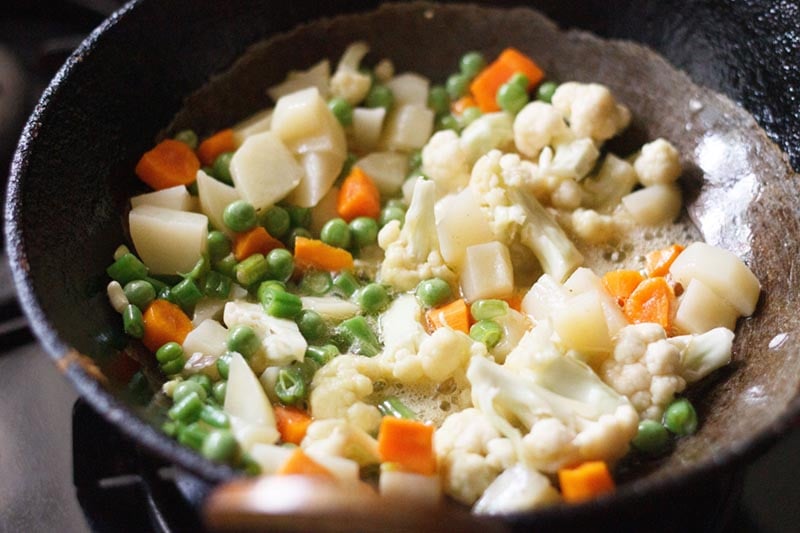

2. Fry vegetables on medium to medium-high heat, turning them over as needed. Ensure to fry until they are cooked completely and are tender and golden from the edges.
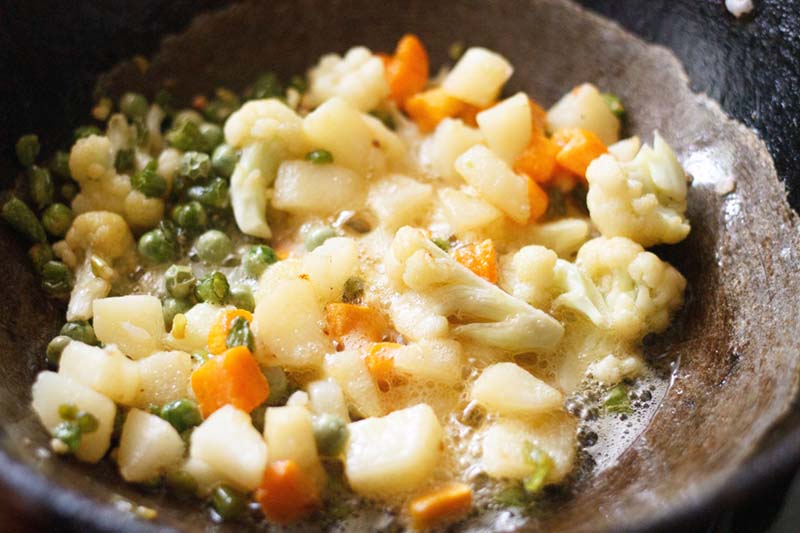

3. Remove with a slotted spoon and drain on kitchen paper towels to remove excess oil.
Instead of frying, you can even steam or roast the vegetables in an oven.
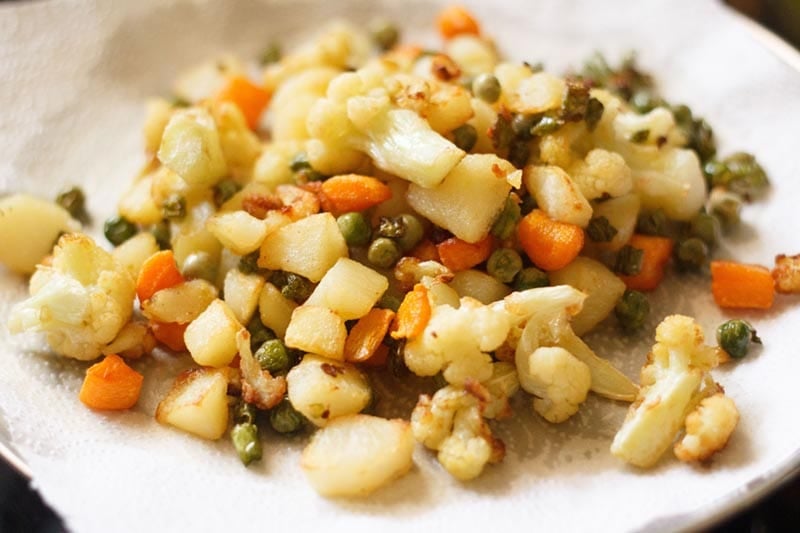

Frying & Sauteing
4. In the same oil, add 2 slit green chilies and 10 to 12 whole cashews. Fry till the cashews are golden and the chilies have some light blisters on them. Do not brown or burn the chillies.
Remove with a slotted spoon and drain on kitchen paper towels.
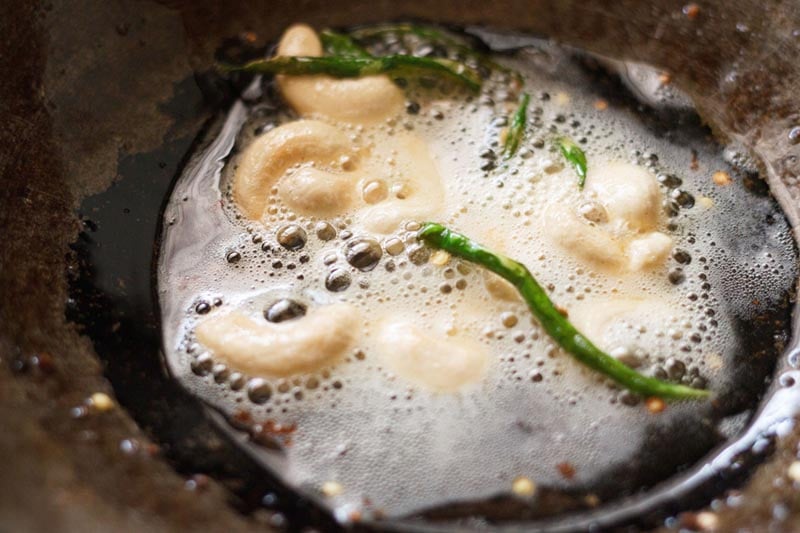

5. Keep the heat to low or turn off the heat. Add 1 generous pinch of asafoetida and stir.
If you do not have asafoetida, then simply omit adding it.
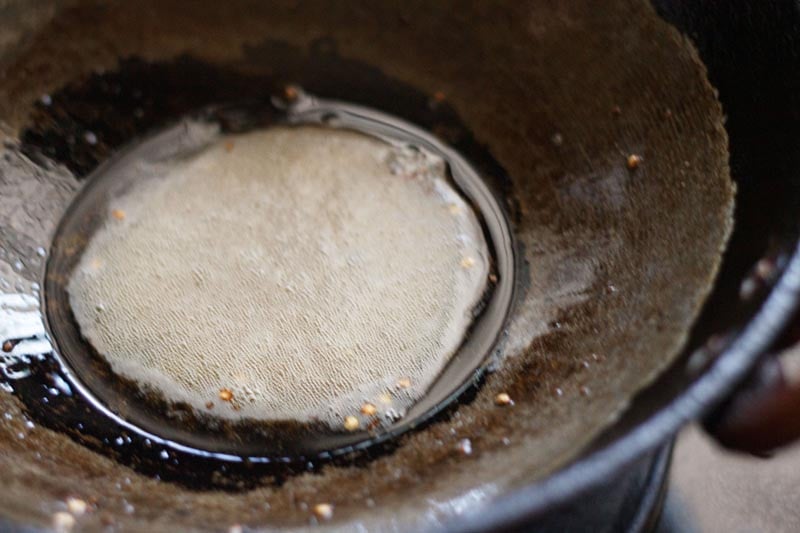

6. Next, add ⅓ cup finely chopped onions. Stir and sauté on medium heat until the onions turn light golden.
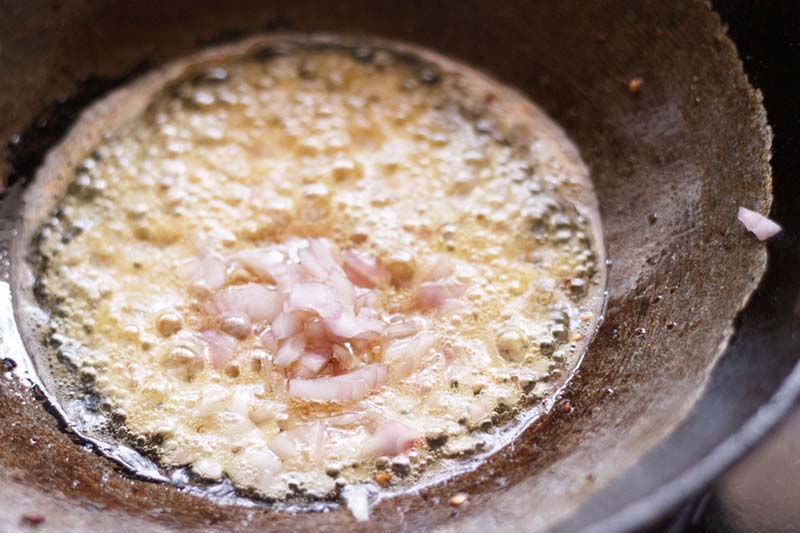

7. Add 1 teaspoon ginger-garlic paste or crushed ginger-garlic. Sauté on medium-low heat until their raw aroma dissipates.
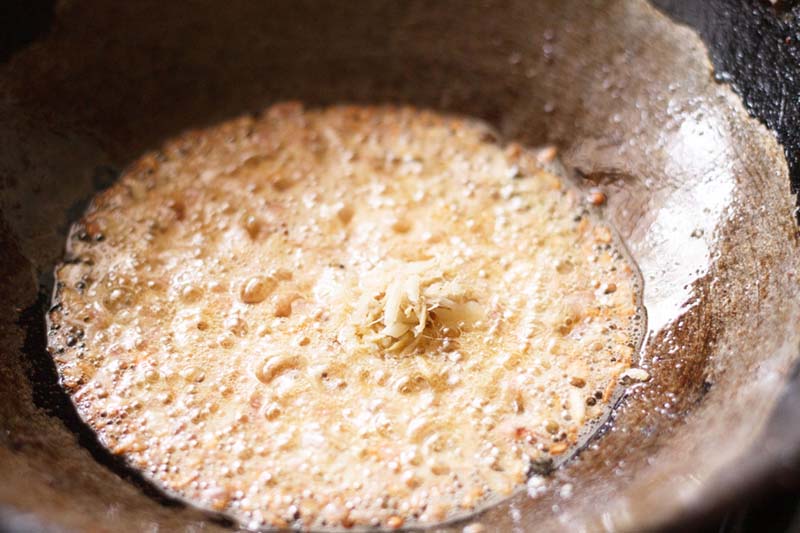

Make Onion & Tomato Masala
8. Add ¾ to 1 cup finely chopped tomatoes. Stir and sauté until the tomatoes become pulpy and you see oil releasing from the sides.
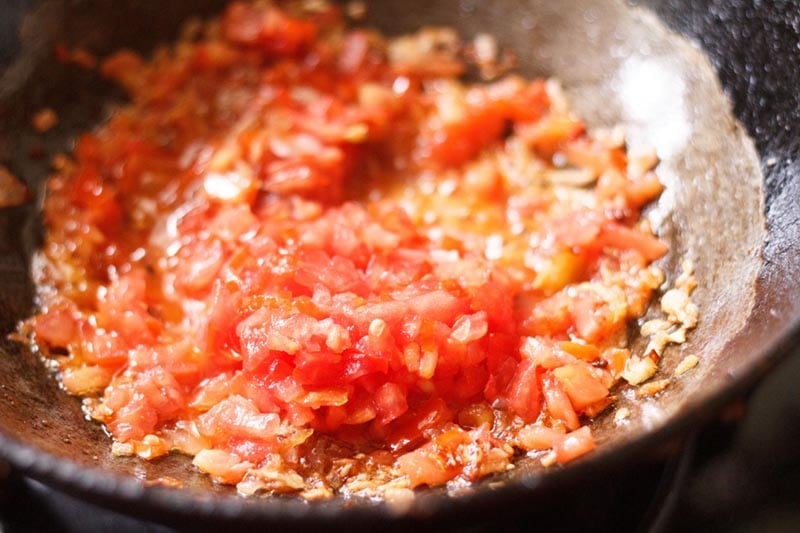

9. Lower the heat and add all the ground spice powders – ½ teaspoon red chili powder, ¼ teaspoon turmeric powder, 1 teaspoon coriander powder and ½ teaspoon garam masala powder.
Stir and mix well. Sauté for a minute on low to medium-low heat.
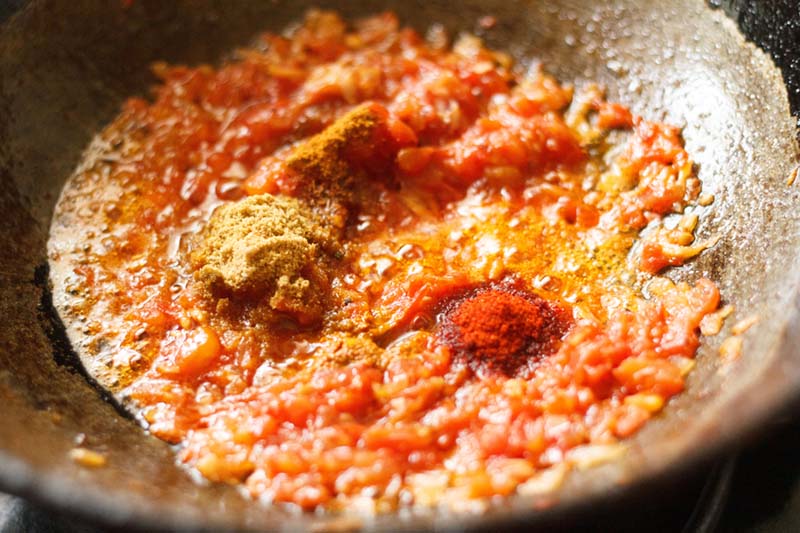

10. Keep the heat to a low and add 2 tablespoons whisked curd (yogurt). Stir curd briskly as you incorporate it into the masala mixture.
Stirring briskly but continuously when adding curd, ensures that it does not split in the onion-tomato masala. Also, use full-fat fresh curd.
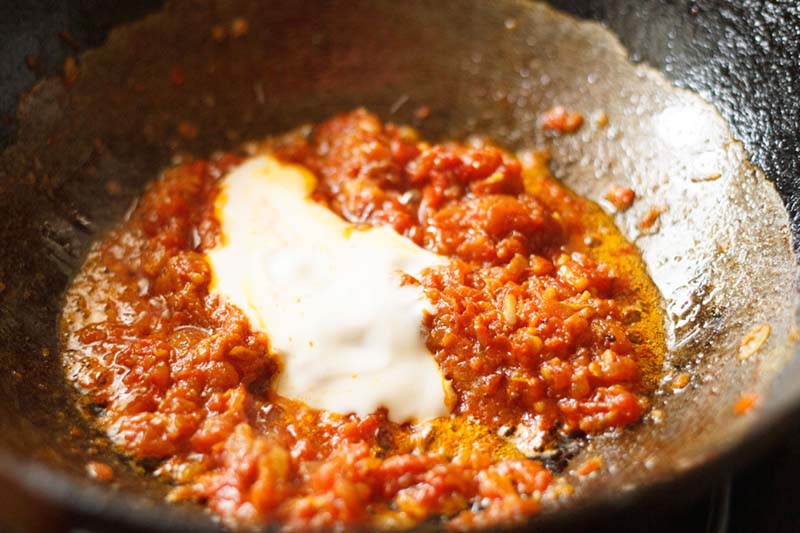

11. Add 3 tablespoons light cream or low fat cream. Again, stir and mix everything very well.
Opt to add 1 tablespoon of heavy or whipping cream, instead of light cream.
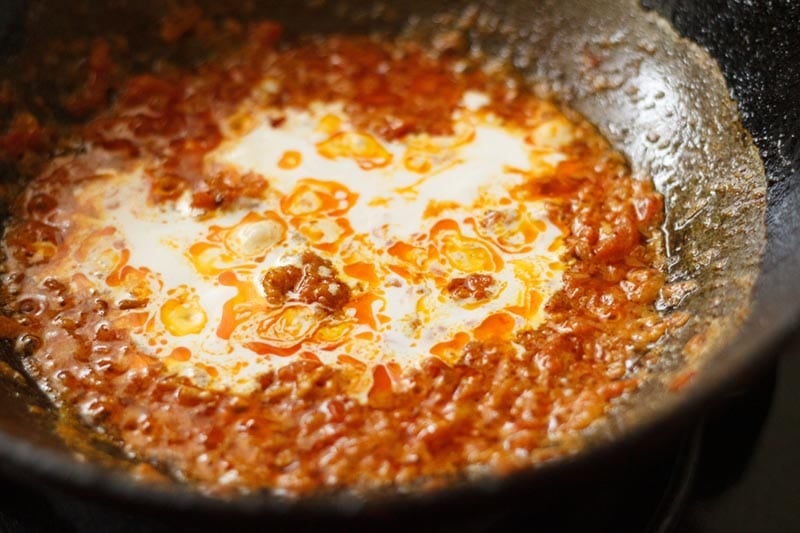

Make Vegetable Curry
12. Next, add ⅓ cup water. Stir well and let the gravy come to a simmer.
Add water depending upon the consistency you want. But don’t make a thin curry or gravy.
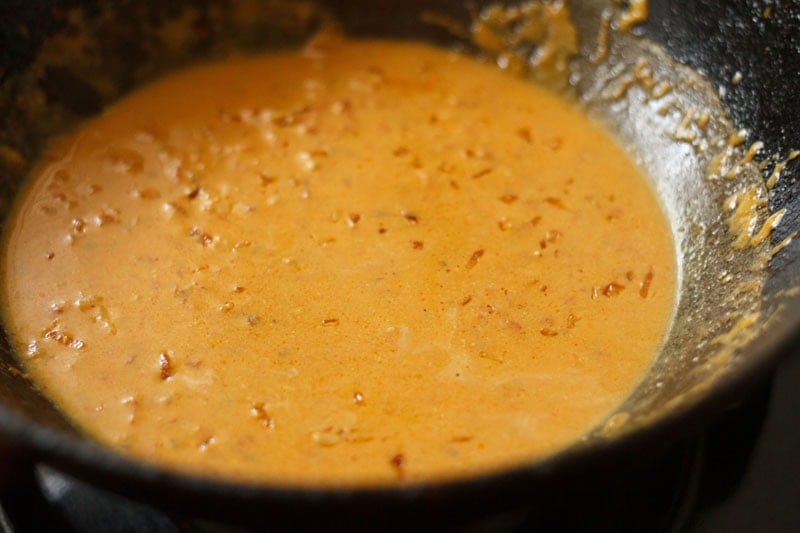

13. When the curry comes to a simmer, then add the fried vegetables, fried cashews and chilies. Also, season with salt.
Here, you can also add paneer cubes along with fried vegetables.
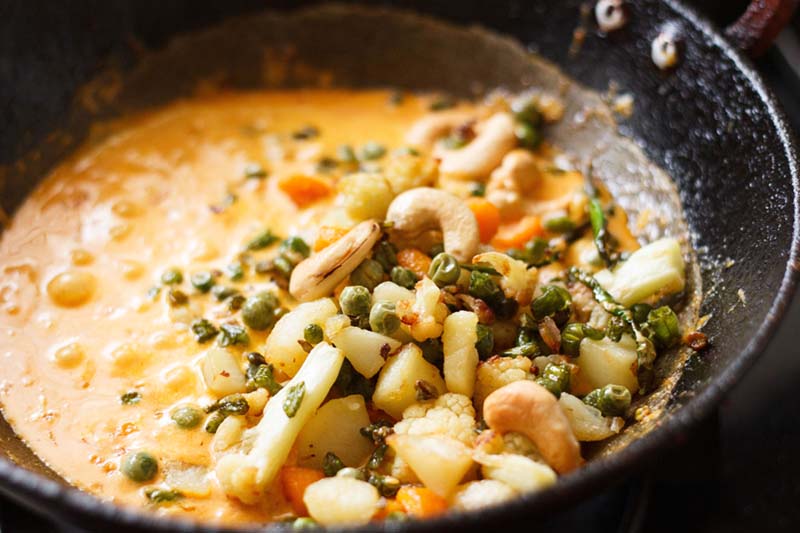

14. Mix and stir the vegetables and let them to simmer in the gravy for 2 minutes on medium-low heat.
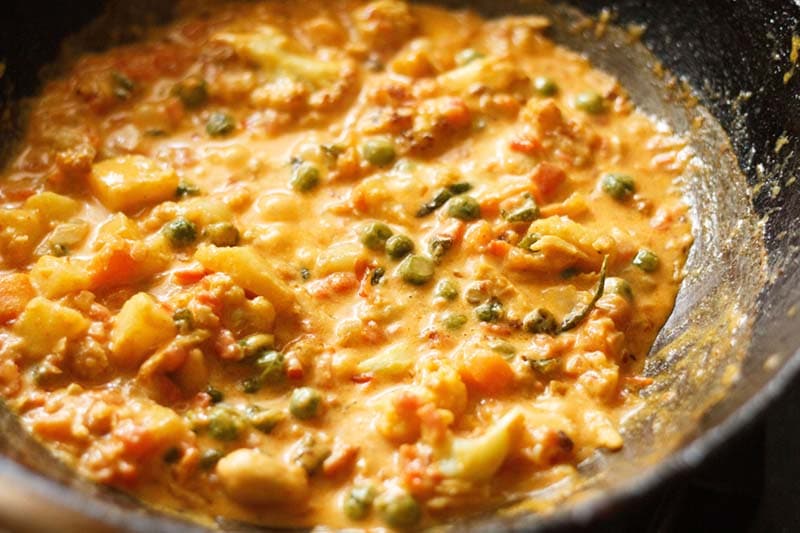

15. Serve Vegetable Curry with naan or tandoori roti or phulkas along with onion-mint-lemon salad.
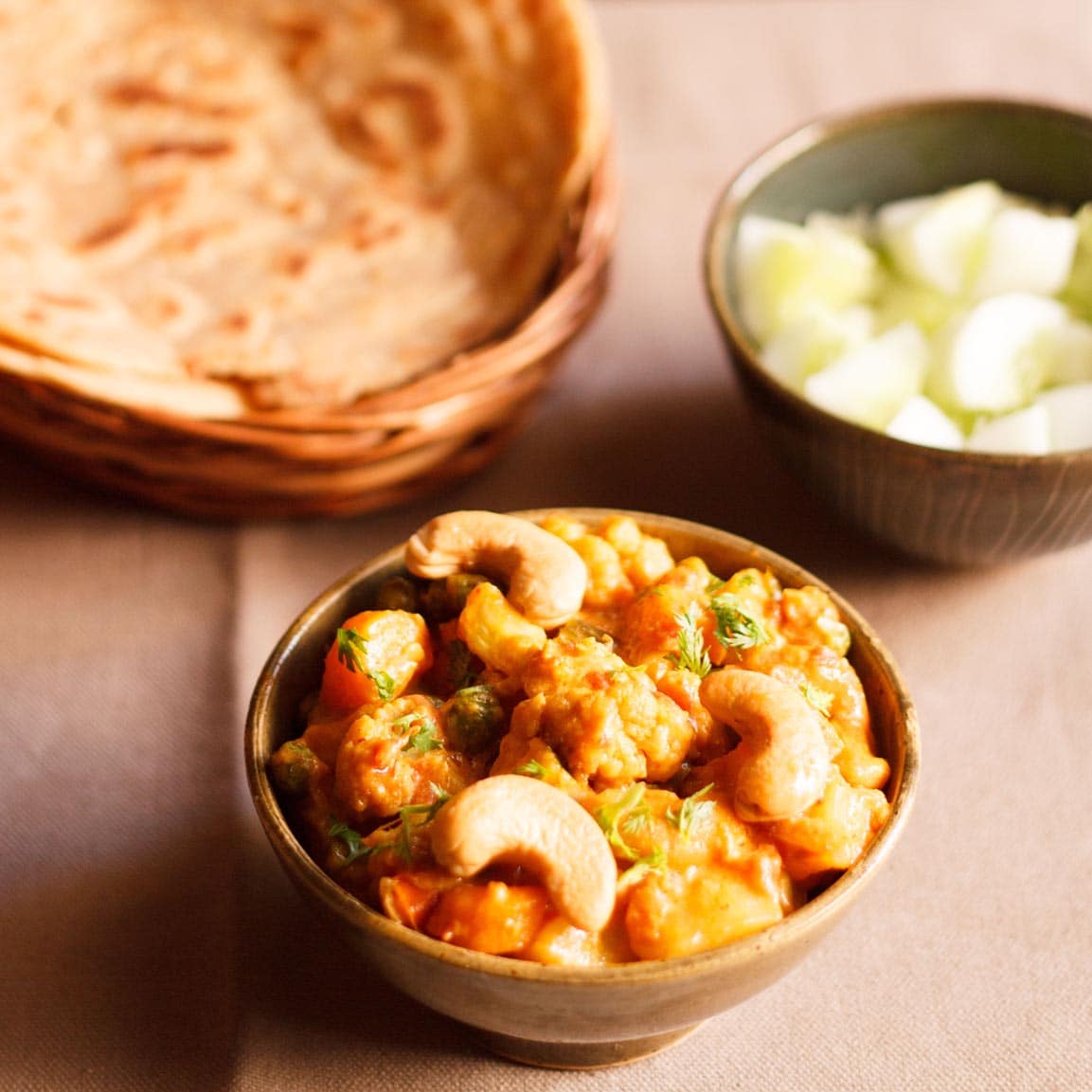

Variations
Here are some variations that can add diversity to the Punjabi-style Vegetable Curry repertoire, allowing you to enjoy different flavors and textures with each preparation:
- Add cubes of Indian cottage cheese (paneer) to the curry for a richer and creamier texture. You can also marinate the paneer in spices and pan frying them, before adding to the gravy or can garnish the vegetable curry with pan fried paneer cubes.
- Add cooked chickpeas (chana/chole) along with vegetables like onions, tomatoes and bell peppers for a protein-rich curry.
- Sauté mushrooms and green peas together with spices like cumin, coriander and garam masala powder to create a delicious curry with earthy flavors.
- Combine cauliflower (gobi) with potatoes (aloo) for a classic Aloo Gobi curry that’s both comforting and tasty.
- Sauté okra (bhindi) separately in oil. Add these to the curry base, simmer for 1 to 2 minutes and enjoy a tangy and flavorful curry.
- Fry or boil tender jackfruit pieces and add them in the masala gravy for a unique and flavorsome vegetarian curry.
Expert Tips
- Choose fresh veggies: Use fresh and seasonal vegetables for the best optimum flavor and taste. Common vegetables used in this curry include potatoes, carrots, green peas, cauliflower, French beans and bell peppers.
- Preparing veggies: Wash and chop the vegetables evenly so they cook at the same rate. You can cut them into cubes or bite-sized pieces, depending on your preference.
- Cooking veggies: Instead of frying the vegetables, you can also sauté or blanch or steam them. You could also roast the vegetables in an oven.
- Layer flavors: Add the ground spices to the onion-tomato base and cook them until the raw smell disappears for about a minute. This step allows the spices to release their flavors and infuse into the curry.
- Adjust consistency: For the desired consistency, add water accordingly. Some prefer a thick gravy, while others prefer a medium to thin consistency.
- Finish with fresh herbs: You can add a garnish of fresh coriander leaves to the curry before serving, for an added color and freshness in the dish.
FAQs
A variety of vegetables like potatoes, carrots, green peas, cauliflower, bell peppers, beans, eggplant can be used. Choose a mix of vegetables that you enjoy.
You can achieve a thick and creamy texture by blending a portion of cooked vegetables before adding them back to the curry. This helps thicken the sauce naturally without the need for cream. Alternatively, you can also use cashew or almond paste to add richness and creaminess.
You have the liberty to adjust the spiciness of the curry according to your palate requirements. You can increase or decrease the quantity of red chili powder or green chilies.
Yes, you can easily make this curry vegan by skipping any dairy-based ingredients such as cream or yogurt. Plant-based milk or coconut milk can also be used for a creamy texture.
More Curries To Try!
Mushroom Recipes
Paneer Recipes
Chickpeas Recipes
Curry Recipes
Please be sure to rate the recipe in the recipe card or leave a comment below if you have made it. For more vegetarian inspirations, Sign Up for my emails or follow me on Instagram, Youtube, Facebook, Pinterest or Twitter.
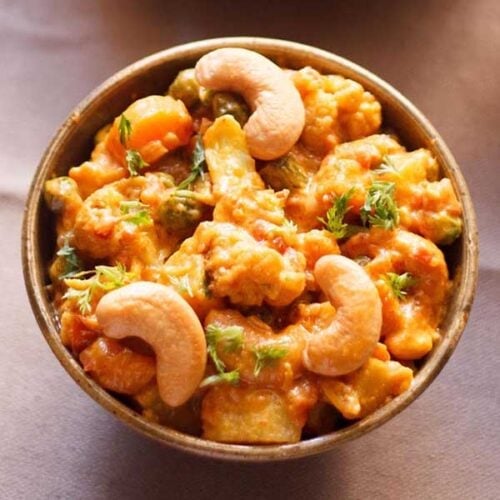

Vegetable Curry Recipe
This Vegetable Curry Recipe is a Punjabi or North Indian-style creamy curry made with mixed vegetables in spiced onion-tomato gravy. Best paired with all your Indian flatbreads and even cumin rice, for a comforting meal.
Prep Time 25 minutes
Cook Time 20 minutes
Total Time 45 minutes
Prevent your screen from going dark while making the recipe
Preparation
Rinse, peel and then chop the veggies.
Chop the carrots, potatoes into cubes and the cauliflower into small to medium sized florets as then it takes less time to fry them.
Making vegetable curry
In the same oil, add the slit green chilies and cashews
- Fry until the cashews are golden and the chilies have light blisters on them. Remove with a slotted spoon and place on kitchen paper towels.Ensure that the chilies do not get more browned or get burnt.
Then add asafoetida and stir to mix.
Next add onions. Stir and sauté on medium heat until the onions turn a light golden.
Add ginger-garlic paste or crushed ginger-garlic. Sauté on medium-low heat until their raw aroma goes away.
Now add finely chopped tomatoes. Stir and saute until the tomatoes become pulpy and you see oil releasing from the sides.
Lower the heat and add all the ground spice powders – red chili powder, turmeric powder, coriander powder and garam masala powder.
Stir and mix well, sautéing the ground spices for a minute on low to medium-low heat.
- Keeping the heat to a low, add whisked curd/yogurt stirring continuously. Stirring briskly when adding curd, ensures that it does not split in the onion-tomato gravy. Also use full fat fresh curd.
Next add then cream. Again stir and mix everything very well.
Now add water. Stir. Add water depending upon the consistency you prefer. But don’t make a very thin curry.
When the curry comes to a simmer add the fried vegetables, fried cashews and chilies. Also season with salt. Here you can also add some paneer cubes.
Mix and stir the veggies and allow them to simmer in the curry for 2 minutes on medium-low heat.
Serve the Vegetable Curry with naan, tandoori roti or roti along with onion-mint-lemon salad. Sprinkle some chopped coriander leaves while serving.
- Instead of frying the vegetables, you could saute the vegetables or also blanch or steam them.
- You can opt for a thick consistency in the curry or a medium to slightly thin consistency, but do not make it very thin.
- For a spicy curry, add more green chilies and red chilli powder.
- Do not use low fat or toned curd (yogurt) as these may separate in the curry. Ensure that the curd is not very sour or tangy.
- You could include any of your preferred mix vegetables.
- If you do add paneer, then include them towards the end. Stir to combine and turn off the heat.
- Make sure that the tomatoes are not too sour as this may make the curry too tangy.
Nutrition Facts
Vegetable Curry Recipe
Amount Per Serving
Calories 490 Calories from Fat 306
% Daily Value*
Fat 34g52%
Saturated Fat 10g63%
Cholesterol 39mg13%
Sodium 562mg24%
Potassium 1200mg34%
Carbohydrates 38g13%
Fiber 10g42%
Sugar 10g11%
Protein 12g24%
Vitamin A 4740IU95%
Vitamin B1 (Thiamine) 1mg67%
Vitamin B2 (Riboflavin) 1mg59%
Vitamin B3 (Niacin) 3mg15%
Vitamin B6 1mg50%
Vitamin B12 1µg17%
Vitamin C 92mg112%
Vitamin D 1µg7%
Vitamin E 9mg60%
Vitamin K 28µg27%
Calcium 230mg23%
Vitamin B9 (Folate) 86µg22%
Iron 6mg33%
Magnesium 81mg20%
Phosphorus 187mg19%
Zinc 1mg7%
* Percent Daily Values are based on a 2000 calorie diet.
This Vegetable Curry recipe from the blog archives was first published on December 2014. It has been updated and republished on May 2024.
Source link

